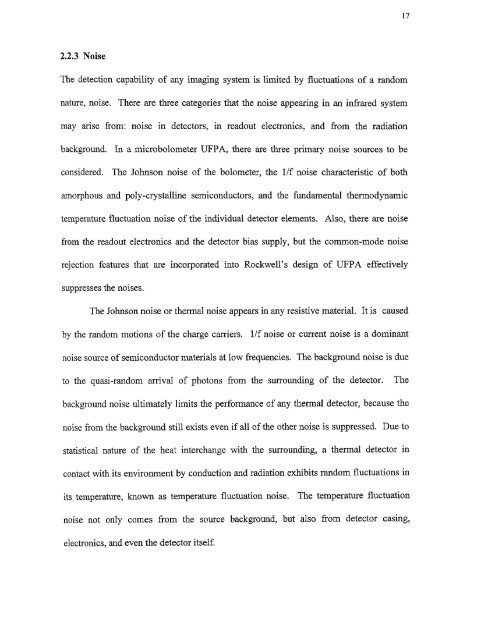Analysis of 320X240 uncooled microbolometer focal plane array ...
Analysis of 320X240 uncooled microbolometer focal plane array ...
Analysis of 320X240 uncooled microbolometer focal plane array ...
You also want an ePaper? Increase the reach of your titles
YUMPU automatically turns print PDFs into web optimized ePapers that Google loves.
172.2.3 NoiseThe detection capability <strong>of</strong> any imaging system is limited by fluctuations <strong>of</strong> a randomnature, noise. There are three categories that the noise appearing in an infrared systemmay arise from: noise in detectors, in readout electronics, and from the radiationbackground. In a <strong>microbolometer</strong> UFPA, there are three primary noise sources to beconsidered. The Johnson noise <strong>of</strong> the bolometer, the 1/f noise characteristic <strong>of</strong> bothamorphous and poly-crystalline semiconductors, and the fundamental thermodynamictemperature fluctuation noise <strong>of</strong> the individual detector elements. Also, there are noisefrom the readout electronics and the detector bias supply, but the common-mode noiserejection features that are incorporated into Rockwell's design <strong>of</strong> UFPA effectivelysuppresses the noises.The Johnson noise or thermal noise appears in any resistive material. It is causedby the random motions <strong>of</strong> the charge carriers. 1/f noise or current noise is a dominantnoise source <strong>of</strong> semiconductor materials at low frequencies. The background noise is dueto the quasi-random arrival <strong>of</strong> photons from the surrounding <strong>of</strong> the detector. Thebackground noise ultimately limits the performance <strong>of</strong> any thermal detector, because thenoise from the background still exists even if all <strong>of</strong> the other noise is suppressed. Due tostatistical nature <strong>of</strong> the heat interchange with the surrounding, a thermal detector incontact with its environment by conduction and radiation exhibits random fluctuations inits temperature, known as temperature fluctuation noise. The temperature fluctuationnoise not only comes from the source background, but also from detector casing,electronics, and even the detector itself.
















